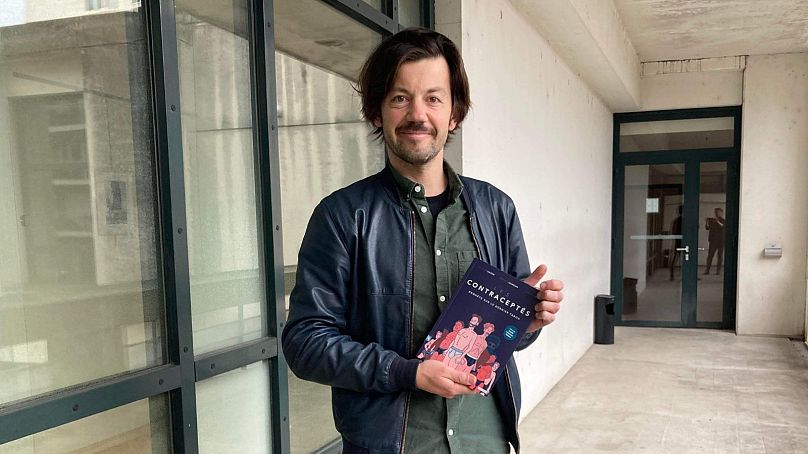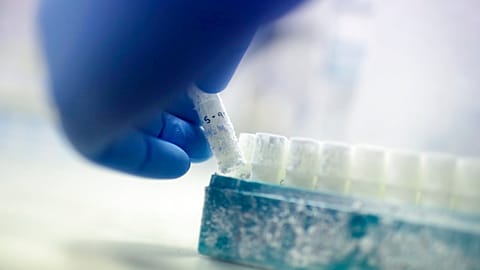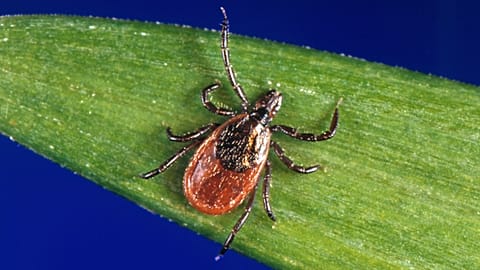From homemade jockstraps to a shoulder gel that slashes sperm counts, these new male contraceptives look to better share the burden of birth control.
 ADVERTISEMENT
ADVERTISEMENT
Mary Arnold had been on the pill half her life when she declared she couldn’t stand it any more.
A 31-year-old dietician living in Seattle, the US, Arnold suffered migraine with aura - a severe form of headache that can affect your senses and speech - and her doctor told her that put her at higher risk of a stroke from taking the pill.
So, she tried switching to an intrauterine device (IUD), but the placement was very painful and it turned into a “really traumatic experience”.
“I just have had a lot of issues with female birth control, just a lot of side effects,” Arnold told Euronews Next. “And after 15 years of being on it, I threw my hands up and was like, I'm done”.
For decades, women have borne most of the responsibility when it comes to birth control - whether it’s remembering to take the pill every day at the same hour or enduring the physical and emotional side effects of contraception.
A growing number of men are feeling their pain and are willing to take a more active role in preventing unwanted pregnancies. The problem is, there are no options for them beyond using condoms or getting a vasectomy, which is not an easily reversible procedure.
So, when Arnold’s 31-year-old partner Patrick Leonard saw an ad on social media for a clinical trial of a new male contraceptive, they discussed it together and decided to give it a go.
They are part of a growing cohort of couples testing the safety and efficacy of novel forms of male birth control. While they have now wrapped up their trial, they look back on it positively.
Every day for a little over a year, Leonard rubbed an experimental contraceptive gel, Nestorone, on both his shoulders. The gel contains testosterone and Nestorone, a progestin - or synthetic progestogen - which has been shown to suppress sperm production.
Male contraception experts say the trial, which has enrolled 460 couples worldwide, is the most advanced so far and has the potential to shake up the future of birth control. Not a single couple has gotten pregnant while on the gel, and no serious adverse events have been reported, said Regine Sitruk-Ware, who oversees the trial.
“It's been the most effective form of birth control for us so far in our experience, with the fewest side effects overall for us as a partnership,” Leonard told Euronews Next.
While he has suffered some side effects, mainly weight gain and mood swings, “it was a really great exercise in empathising with what women have gone through for decades,” he said.
There are other new forms of male contraception in development around the world, including hormonal methods and a "vas-occlusive gel" that works like a reversible vasectomy, allowing fluid to flow from the penis but stopping sperm from travelling.
And there are men trying more homemade, heat-based contraceptive methods - which have not gone through proper clinical studies - aimed at raising the temperature of their testicles to suppress sperm production. These involve wearing a special jockstrap or a silicone ring to hold their testicles up against their body.
Shouldering responsibility
For Alex Springer, joining the Nestorone trial was also a way to relieve his partner Mel Hopkins, who has type 1 diabetes. A 28-year-old nurse, she felt hormonal contraception made her blood sugar levels more difficult to manage and described herself as someone who has been unhappy with every form of birth control since she was 16.
“I think in any kind of healthy relationship, you look for give and takes,” Springer said. “And when it's clearly something that's affecting her, if I can shoulder that responsibility easily with very minimal side effects - if any - then why wouldn't I do that? It seems like just part of being in a supportive relationship”.
Hopkins immediately welcomed her partner’s offer, saying developing more options for male contraception “seems totally reasonable”.
“Women can have one baby per year. Men could get a thousand people pregnant per year. So I feel like they should take more responsibility,” she said.
Springer said using the contraceptive gel quickly turned into an easy routine.
“It's like putting on your deodorant every morning,” he said.
He described the gel as clear, somewhat watery, with a slightly alcoholic smell to it - “a bit like hand sanitiser” - which makes it quick to absorb.
You take one squirt the size of a coin in the palm of your hand and rub it on the opposite shoulder, then repeat the action on the other side, he explained.
“It dries on quickly with no residue and basically by the time I'd put it on in the bathroom and walk around to the closet to put on a shirt, it was dry and ready to go”.
Risks vs benefits
The only side effects Springer ever noticed were night sweats. “I would just wake up, like, really hot,” he said, adding that this was such an insignificant side effect compared to some of those caused by female birth control that “it’s almost not even worth mentioning”.
Leonard, for his part, said he was noticeably more irritable. He also gained over 11 kg (going from 65 kg to 77 kg), which the doctors supervising the trial were surprised about - putting on 4 to 7 kg would have been more in line with expectations.
Both Springer and Leonard had to get sperm counts and blood work done every month to monitor any abnormal changes and ensure their sperm production stayed suppressed below 1 million sperm per millilitre, the threshold at which a pregnancy is deemed nearly impossible.
Still, considering the contraceptive is an experimental one, a million sounds like a lot of swimmers, and Hopkins worried she might get pregnant: “That was crazy to me. I was like, Are you kidding? A million?”
Another concern for the couples was reversibility.
“Because when you go off of it, it takes three months or so for the sperm count to go back to normal,” said Hopkins. “So we were like, what if that doesn't happen? What if it's permanent?”
“I guess in the background, the main fear is that I'll be sterile forever,” said Leonard. “But we were pretty well set at ease by the data so far from the study. It clearly suggests that it's safe and effective and reversible, so that concern was laid to rest pretty quickly”.
Studies into new forms of birth control need to ensure that the contraceptive effect is fully reversible once people stop taking them. This means trials need to also monitor whether people go on to have children afterwards, which helps explain why the research takes so long.
Sitruk-Ware said the plan was to approach health authorities - mainly the US Food and Drug Administration (FDA) - in the coming months, with the hope of starting the first Phase III trial of the gel later this year. That’s the last stage of clinical studies before a health product can be reviewed by regulators and put on the market.
But even if that late-stage trial started in 2023, she estimated that “we’ll need another four years to complete it, and let’s say a year for approval”.
The problem when you’re breaking new ground is that there are all sorts of hurdles to overcome, explained Sitruk-Ware, who has worked on male contraceptive research for the Population Council for the past two decades.
“We hope to make a product which will be the first of its kind, and it will open up the path for other methods, because the discussions we have with the health authorities will set out guidelines that for the moment do not exist,” she said.
Going all in
Guillaume Daudin, a French journalist, co-authored a graphic novel (“Les Contraceptés”) on the men breaking the “taboo” of male contraception in the country.
The book depicts men joining what sounds like Tupperware parties where they learn how to sew special jockstraps to raise the temperature of their testicles and temporarily halt sperm production.
It’s called the “thermal method” - but no clinical trial has ever been funded to back it up and ensure its safety over the long run.
To make their customised jockstraps, the men typically cut a rolled-up child’s sock into a soft ring that they push the penis and the skin of the scrotum through. Daudin said that while it may sound scary, “it’s not at all painful”.
Doing so lifts the testicles up against the body and raises their temperature by several degrees, which supposedly halts sperm production if the contraption is worn for at least 15 hours a day.
“It takes getting used to at first, because the positioning is different, so the sensations are a bit different,” Daudin told Euronews Next.
A more compact option is a silicone ring that serves the same purpose - and which Daudin himself eventually ended up wearing on a daily basis for about two years.
“While I had a hard time picturing myself with the jockstrap, the ring sounded harmless, almost like the male equivalent to having an IUD or wearing a bra,” he said.
It’s worth noting that the ring, called Andro-Switch, was pulled from the market by France’s National Agency for Medicines and Health Products Safety (ANSM) in December 2021.
The regulator said the device needed to prove its safety and efficacy in a clinical trial before it could be used by the general public.
The cooperative behind the product has since received $300,000 (over €275,000) of funding from the non-profit Male Contraceptive Initiative (MCI) to launch the studies. It will likely take several more years to complete these.
Facing resistance
From Seattle to Paris, the couples testing new forms of male contraception say they’ve ended up becoming advocates for them.
Springer described a political divide when it comes to how people feel about male birth control, and said the US Supreme Court’s rollback of Roe v Wade, which had established the constitutional right to abortion, had made some men with progressive values willing to do more to prevent unwanted pregnancies.
The financial compensation for taking part in trials like the Nestorone one - a few thousand dollars a year, on top of free contraception - “could also make a huge difference for low-income folks,” said Arnold.
She and Leonard have yet to convince any of their own friends to join the trial.
“They hear about it and they're like, ‘Oh, that's so cool, good for you!’” she said. But when she asks them if they want the contact information, “no thanks” is their polite answer. “No one went through with it. No one,” she said, voicing frustration.
“If more people would be more willing to get into the study, I just feel like this would move forward so much faster”.
Daudin said men’s reluctance centred around projections of virility and fears of feeling castrated. He managed to convince three friends to also “contracept” themselves. One of them gave up because it made him itchy.
Daudin himself has now stopped, as his partner decided to get back on contraception to help regulate her menstrual cycles. But for the two couples in Seattle, it was a disappointment to reach the end of their enrollment in the study after a little over a year of using the shoulder gel.
“I was so sad when the trial ended,” Hopkins said. After three months off the gel, Springer’s sperm counts had returned to normal. The couple is now back on condoms, and hoping the gel will eventually get marketing approval.
“The whole thing is very exciting and it feels great to be a part of it,” said Leonard, adding he and Arnold would likely re-enrol in the study if they could.
“But there’s no word on that, so we'll have to wait until it comes to market, I guess”.




















